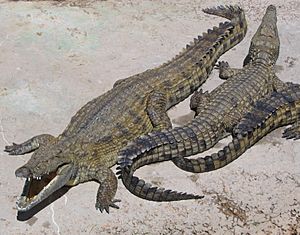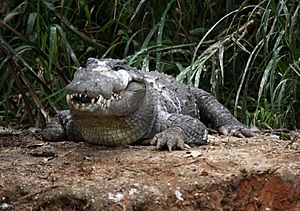Crocodile facts for kids
Quick facts for kids CrocodilesTemporal range: Eocene – Recent
|
|
|---|---|
 |
|
| Nile Crocodile | |
| Scientific classification | |
| Kingdom: | |
| Phylum: | |
| (unranked): | |
| Class: | |
| Order: | |
| Family: |
Crocodylidae
Cuvier, 1807
|
| Genera | |
|
|
A crocodile is a large reptile that lives both on land and in water. These amazing animals mostly live in big rivers in warm, tropical places. They are ambush predators, meaning they hide and wait to surprise their prey. One type, the saltwater crocodile from Australia, can even swim in salty ocean water.
Some scientists think modern crocodiles first appeared during the Eocene period, which was millions of years ago. Other scientists believe their ancestors are even older, going back to the Upper Triassic period. Crocodiles are part of a group called Archosaurs, which also includes the dinosaurs. There are many different kinds of crocodiles, like the American, slender-snouted, and Orinoco crocodile.
Crocodiles can snap their jaws shut very quickly and with incredible power. But it's hard for them to open their jaws. A person could actually hold a crocodile's mouth shut with their hands! Crocodiles come in different sizes. African Dwarf crocodiles are usually no more than 5 feet long. Saltwater crocodiles, however, can grow to be almost 23 feet long!
Contents
Where Crocodiles Live
Crocodiles live in rivers, lakes, and dams. You can find them in parts of America, Asia, Africa, and Australia. Some Australian crocodiles live in salt water, and these are usually bigger than the ones that live in fresh water.
Even though crocodiles spend most of their time in the water, they can come out and move around on land. Crocodiles cannot breathe underwater like fish. They breathe air, just like people do. They can hold their breath for about two hours when they are underwater.
What Crocodiles Look Like
Crocodiles can be brown, grey, or sometimes greenish-brown. They have different patterns covering their bodies. They also have sharp claws and teeth.
A crocodile's tongue is not like a human's. It's held in place by a special membrane and cannot move freely. This means crocodiles cannot stick out their tongues.
Crocodiles vs. Alligators
Alligators and crocodiles look similar, but they have some key differences:
- Crocodiles have special glands that help them live in saltwater. Alligators usually live in freshwater.
- Crocodiles often have longer, narrower snouts that look like a "V" shape. Most alligators have wider snouts that look like a "U" shape.
- When a crocodile closes its mouth, you can usually see its fourth tooth on the lower jaw sticking out. You cannot see this tooth when an alligator's mouth is closed.
What Crocodiles Eat
Crocodiles are carnivores, meaning they eat meat. They mostly eat fish, amphibians, crustaceans (like crabs), molluscs (like snails), birds, other reptiles, and mammals. Sometimes, larger crocodiles might even eat smaller crocodiles. What a crocodile eats depends on its species, size, and age.
Young crocodiles usually hunt small invertebrates and tiny fish. As they grow, they start hunting larger prey. Crocodiles have a very slow metabolism, which means they can go a long time without eating.
Even though they might look slow, crocodiles can strike very quickly. They are top predators in their homes. Some crocodiles have even been seen attacking and killing other predators like sharks and big cats. Crocodiles are also known to be aggressive scavengers. This means they will eat dead animals or steal food from other predators. Some evidence even suggests that crocodiles eat fruits!
How Crocodiles Defend Themselves
Crocodiles protect themselves using their tough bodies, strong abilities, sharp senses, and smart behaviors like hiding.
Tough Skin (Scutes)
Crocodiles have incredibly tough, leathery skin. This skin is made even stronger by bony plates called scutes (pronounced skoots). Scutes are like built-in armor, especially on their back and tail. They are very hard for most predators to bite through. While the scutes are tough, the skin between them is flexible, allowing the crocodile to move easily.
Powerful Bite
Crocodiles have super strong muscles for closing their jaws. When they bite down, they can create a huge amount of force. This powerful bite helps them catch prey and can also be a strong defense against an attacker. Their mouths are full of sharp, cone-shaped teeth perfect for gripping.
Even though their closing muscles are strong, the muscles for opening their jaws are quite weak. This is why you might see people holding a crocodile's mouth shut with tape or rope.
Strong Tail
A crocodile's tail is long, muscular, and incredibly strong. It's essential for swimming, helping the crocodile move quickly through the water. On land or in shallow water, a crocodile can use its tail like a whip. A powerful swing of the tail can knock over or seriously hurt an attacker. The tail also helps the crocodile balance.
Blending In (Camouflage)
Crocodiles are masters of camouflage. This is a quiet but very effective way they defend themselves. Their skin color, which is usually dark green, brown, or gray, helps them blend in perfectly with the muddy water and riverbanks where they live. Their bumpy skin also makes them look like logs or rocks when they are still.
By blending in, crocodiles can hide from anything that might threaten them. This helps them avoid fights, which is often the safest way to stay safe. They can lie mostly underwater with just their eyes and nostrils showing, making them almost invisible.
Cool Facts About Crocodiles
- Crocodiles replace their teeth many times, up to 50 times in their lives! Humans only get two sets of teeth (baby and adult).
- Crocodiles cannot sweat to cool down. Instead, they open their mouths to let heat escape. This is called "mouth gaping."
- A crocodile's bite is almost three times stronger than a lion's or a tiger's. It's the strongest bite of any animal in the world!
- When a crocodile catches large prey, it spins its body. This helps to make the prey dizzy and tear off pieces of meat.
- The saying "crocodile tears" means to show fake sadness. Crocodiles do shed tears when they swallow too much air, but it's not because they are sad.
- Because crocodiles cannot chew their food, they swallow stones. These stones help their stomach break down the food they eat.
- A crocodile's stomach has the strongest acid of any animal with a backbone. They can easily digest bones, hooves, and horns.
Images for kids
-
Skulls and scutes of American, Nile and Saltwater crocodiles
-
Crocodiles, like dinosaurs, have special belly ribs called gastralia.
-
A saltwater crocodile in captivity
-
A Nile crocodile trying to swallow a big Tilapia fish in Kruger National Park, South Africa
-
Crocodiles in Costa Rica
-
An American crocodile at La Manzanilla, Jalisco, Mexico
-
A crocodile warning sign in Trinity Beach, Queensland, Australia
-
A famous 1876 cartoon by Thomas Nast
-
Wallets made from crocodile leather from a Bangkok crocodile farm
-
A plate of crocodile meat in teriyaki sauce in Helsinki, Finland.
-
A statue of Sobek, an ancient Egyptian crocodile deity
See also
 In Spanish: Cocodrilos para niños
In Spanish: Cocodrilos para niños
























